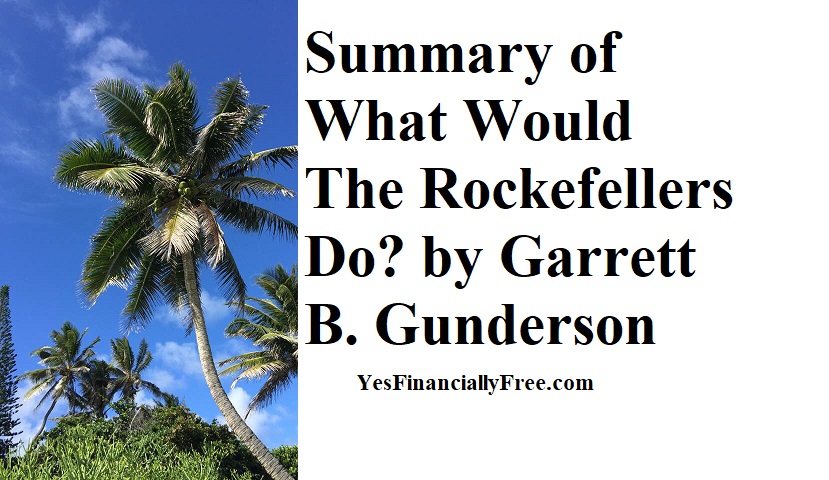
Summary of What Would The Rockefellers Do? by Garrett B. Gunderson
This is a summary of the book What Would The Rockefellers Do? by Garrett B. Gunderson.
The book details how 2 powerful and extremely rich families, the Vanderbilts and the Rockefellers handled their money when they died.
The Vanderbilt fortune was lost by the next generation.
The Rockefeller fortune is still around.
The difference is the Rockefeller fortune has a family office to lend money to the Rockefeller descendants.
If they pay back their loans they can keep borrowing.
If they don’t pay back a loan then they can’t borrow more.
The key though is that the trust buys whole life insurance for every Rockefeller descendant, so that if they don’t pay back their loan, the life insurance will pay back the trust when they die.
That’s how the Rockefeller fortune always has money, generation after generation.
Some key points:Whole life insurance is a certainty (as long as you pay your premiums) that you can pass on a certain guaranteed amount of money when you die.
Gunderson says that the certainty of knowing the money will be there when you die will make you more productive at living, and allow you to have a more fulfilled life.
Be sure to get whole life insurance from well established companies that have been around for at least 100 years.
There are ways to structure a policy so that there is more cash value up front.
If you already have a policy that had little to no cash value up front, it’s better to keep it because you’ve already paid the insurance commission, and the underwriting locked you in at a younger age so your premiums are cheaper.
Paid up additions within your current policy (you need to have a rider allowing you to get paid up additions) can increase your insurance coverage (face value) without paying out more commissions for the insurance agent. This is cheaper for you than getting additional insurance policies.
Term life is expensive because you could be putting money into Whole life instead and whole life insurance will be there when you die. Term life premiums once paid are lost forever. In addition, statistics show that only 1% of term life is ever used. Whereas 4% of disability is used.
Gunderson feels it’s wiser to get Whole Life insurance with disability insurance, that way if you ever get disabled your whole life premiums will still get paid.
Gunderson says if you can’t afford Whole life insurance, then get Term with the ability to convert to whole life, so that you can convert it to whole life later when you do have enough money.
He also says get as much insurance as you can qualify for, because your life value is more than any amount of life insurance that you can get.
He also says that when you have more money, assets and wealth, you will get more insurance to protect what you have.
Insurance gives you peace of mind and frees up your money for other opportunities.
He gives some examples:
——————————–
Charitable trust
If you have a building worth $1,000,000 and you sell it, you have to pay from $200,000 to $300,000 in taxes!
If you instead donate the building to a charitable trust, a portion of the asset you donated is tax deductible.
In addition, you only have to donate 10% to the charity (which is better than 20%-30% to the government in taxes), which means 90% goes to you. You set up the trust so that you are first beneficiary and the charity is second beneficiary.
You can then use the money to pay for whole life insurance so when you die, your heirs or trust gets the money replenished tax free.
“That’s why this strategy is so cool: you get to give your money away, spend more money than if you didn’t give your money away, and the life insurance returns the gift back to your heirs, tax-free.”(p.112)
————————–
Living a Better Lifestyle
If you have $1,000,000 in IRAs and property, you can’t spend it when you retire. Instead, you live in fear that you will run out of money before you die.
If you have Whole life insurance of $1,000,000 and you have $1,000,000 in IRAs and property, then you can spend your assets and know that when you die your heirs, legacy will still have money.
In addition, if you spend down all your assets and still are alive and need more money, you can tap into your whole life insurance cash value with loans or withdrawals.
Be Your Own Bank
You can borrow from the cash value in your Whole Life Insurance Policy and pay it back as if it was a bank.
The nice thing is you don’t have to fill out an application, you can get the money in just a couple of days, and you can pay it back as quickly or as slowly as you like.
In addition, when you borrow money out of your cash value, the money still accrues dividends at a set minimum rate as if you didn’t take it out at all.
Also you are never taxed on the dividends you accrue in your policy if you are borrowing the value out.
The interest rate might be higher than a loan from a bank (or may not depending on your credit score), but it’s way more convenient.
This can lead to further savings, because if you can borrow from your whole life to make a large purchase such as a car or a house…often times you can buy cheaper or get a deal if you buy cash upfront, using your whole life insurance loan money.
Then pay it back in installments as if it were a bank.
There’s flexibility and it’s your choice how you want to structure it.